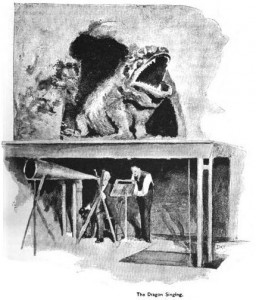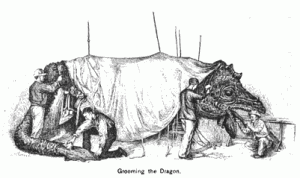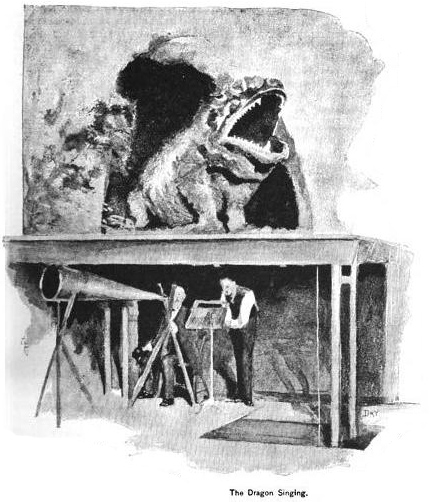The following is an excerpt from “Behind the Scenes of an Opera-House”, written in 1888. The author, Gustav Kobbé, tours the backstage of the Metropolitan Opera in New York City. Be sure to check out the previous excerpts on technical rehearsals, constructing a giant “Talepulka” idol and introducting the series when you are finished here!
Behind the Scenes of an Opera-House, by Gustav Kobbé.
It is noteworthy in connection with this circumstance that the apparatus was devised by an Englishman and that Wagner employed an English property-master to design and make the dragon for the “Siegfried” performances at Baireuth. The English pantomime productions, which involve the manufacture of numerous mechanical and trick properties, have sharpened the ingenuity of English property-masters until they have come to be acknowledged at the head of their profession. “Siegfried” never having been given in England by any but a German company whose scenery and properties were brought from Germany, the combat with the dragon remained as ludicrous a feature of the performances of this work as it was conceded to have been at Baireuth, until the production of “Siegfried” at the Metropolitan Opera-House. For this a dragon was designed and manufactured which the German artists declare to be the most practical and impressive monster they have seen.

The head of this dragon is of papier-mache. The body, thirty feet long, is of thin wire covered with curled leather scales, which are bronzed and painted. This monster, in spite of its size, is worked by a boy who is the dragon’s front legs. He is dressed in a suit of canvas painted the color of the dragon’s hide and having curled leather scales on the trousers below the knees, his shoes being the huge clawed feet. He gets into the dragon behind its head, which conceals him from the waist up, his legs being the dragon’s front legs. With his hands he opens and closes its huge mouth and shoves its eyelids over its eyes when it expires. The steam which it breathes out is supplied through an elastic pipe which, entering at the tail, runs through to the throat. The scene lasts about forty minutes and is very exhausting to the front legs. In Germany the artist who sings the dragon’s part is inside the hide and sings through a speaking trumpet. At the Metropolitan Opera-House the artist sits under the raised bridge upon which the dragon is placed and sings through a speaking trumpet. His music is on a stand, a stage-hand throws the light of a lamp upon it, and the solo répétiteur gives him his cues from the wings. The voice sounds as though it issued from the dragon’s throat. The advantage of this arrangement is that it places in the monster a person whose attention is concentrated upon working this mechanical property in the best possible manner. The dragon when not in commission is stabled in mid-air under the paint-bridge. The day of the performance it is lowered by ropes, thoroughly groomed, and then allowed to stretch itself out upon the floor against the rear wall and lie there until the end of the first act.

First printed in “Behind the Scenes of an Opera-House”, by Gustav Kobbé. Scribner’s Magazine, Vol. IV, No. 4, October 1888.





